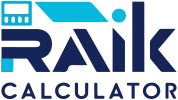What is the Cost of Equity?
Cost of equity is essentially the return that a company must offer to its shareholders to compensate them for the risk of investing in the company’s equity. It’s an important metric for both businesses and investors when assessing the profitability of investments. Think of it like a required return rate for equity investments – if the returns are too low, shareholders might jump ship and take their money elsewhere. The Cost of Equity Calculator helps in determining this rate.
Why Use a Cost of Equity Calculator?
Calculating cost of equity can be quite tricky, especially when you factor in risk and market variables. The Cost of Equity Calculator simplifies the process, giving you a quick and accurate result without needing a finance degree. Whether you’re an investor trying to assess potential returns or a business figuring out how much return to offer to attract investors, this calculator is a handy tool.
How to Calculate Cost of Equity
The most common formula used in calculating cost of equity is the Capital Asset Pricing Model (CAPM). Here’s the formula:
Cost of Equity (Re) = Risk-Free Rate + Beta × (Market Return – Risk-Free Rate)
Let’s break that down:
- Risk-Free Rate: This is the return you’d expect from a “risk-free” investment, like government bonds.
- Beta: A measure of how much the company’s stock moves in relation to the market. A beta higher than 1 means the stock is more volatile than the market, while less than 1 means it’s less volatile.
- Market Return: This is the return you’d expect from the overall stock market.
Our Cost of Equity Calculator takes this formula and does the math for you, providing a fast and easy way to determine the cost of equity without manually crunching the numbers.
Why Is the Cost of Equity Important?
The cost of equity is critical for both investors and businesses. Investors use it to figure out whether an investment is worth the risk. Businesses use it to determine how much return they need to generate to satisfy shareholders and continue attracting investment. If the return on equity is lower than the cost of equity, that’s a big red flag for shareholders.
Components of Cost of Equity Calculation
When calculating cost of equity, there are a few key components to keep in mind:
Risk-Free Rate
The risk-free rate represents the return on an investment that is theoretically free of risk, like U.S. Treasury bonds. It provides the baseline for what kind of return investors should expect from any investment.
Beta
Beta measures how much a company’s stock price moves relative to the market. If the stock has a beta of 1.2, for example, it means the stock is 20% more volatile than the overall market. Higher beta stocks offer potentially higher returns but also come with increased risk.
Market Risk Premium
The market risk premium represents the difference between the expected return of the market and the risk-free rate. It shows how much return investors expect from a risky investment compared to a “safe” one.
CAPM Formula in Practice
Using the CAPM formula, let’s say the risk-free rate is 3%, the beta of the stock is 1.1, and the expected market return is 8%. The cost of equity calculation would look like this:
Cost of Equity = 3% + 1.1 × (8% – 3%) = 8.5%
In this case, the company needs to offer an 8.5% return to attract investors. Anything lower and investors might see the stock as too risky for too little reward.
Why Use a Cost of Equity Calculator?
A Cost of Equity Calculator removes the headache of manually plugging numbers into the CAPM formula. Whether you’re an investor or a business, the calculator simplifies the process and provides quick and accurate results for determining cost of equity. Plus, it’s free to use, making it accessible for anyone interested in financial analysis.
Conclusion
The Cost of Equity Calculator is an essential tool for anyone looking to assess the return required to attract investors. By simplifying the complex CAPM formula and factoring in key variables like beta, risk-free rate, and market returns, this calculator is your go-to tool for calculating cost of equity. Whether you’re a financial analyst, investor, or business owner, understanding cost of equity can help guide better financial decisions.
